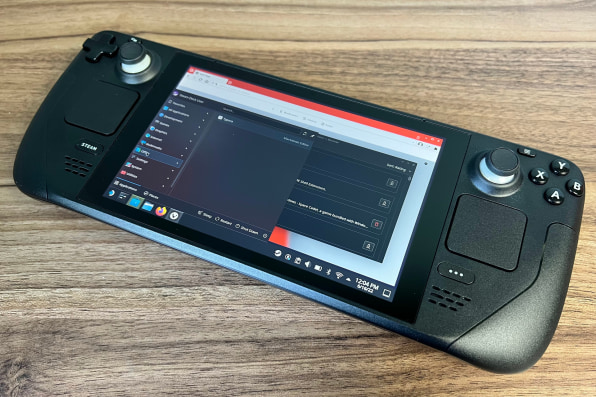Rather than boxing you into its own store, Valve’s portable gaming system lets you install software from anywhere, and it’s glorious.

The Steam Deck is a portable gaming system that breaks the biggest rule of gaming systems.
Unlike practically every major game console that’s come before it, the Steam Deck, from PC gaming giant Valve, doesn’t lock users into one ecosystem. While Valve’s own Steam store is the default way to buy and play games, the Steam Deck also lets users install whatever software they want on the device’s Linux-based operating system.
The experience has been liberating. In recent weeks, I’ve gorged on weird indie creations from itch.io, classic games from GOG.com, and free games from the Epic Games Store. I’ve used Plexamp to stream my personal music collection in place of in-game soundtracks, and I’ve used Vivaldi to browse the web in the Steam Deck’s desktop mode. You don’t have to use your Steam Deck this way, but just being knowing that it’s an option makes the device more capable and personal.
The tech industry is filled with companies that seem deathly afraid of this model, either because they don’t trust their users or don’t want to risk weakening their own ecosystems. By taking the opposite approach, Valve is proving that open platforms aren’t so catastrophic, and it elevates the Steam Deck from yet another gadget into the most exciting consumer electronics device in years.
How Steam Deck sideloading works
Most people will never need to venture beyond the Steam Deck’s standard menu system, which offers a simple way to buy and play games from the Steam store. Valve’s PC game catalog remains unparalleled, so you could be a satisfied Steam Deck user without dipping into its desktop mode.
But if you click the “Power” menu option in Steam Deck settings and select “Switch to Desktop,” that simple interface falls away, revealing the desktop of an Arch Linux computer. This is where the Steam Deck’s possibilities really open up.

Valve has always let users list non-Steam software in their Steam libraries, and that capability carries over to the Steam Deck as well. That means you can install a game from the desktop, add it to Steam, and then launch it through the Steam Deck’s simplified menu system instead of returning to the desktop each time.


Extra safeguards
Working around the Steam interface isn’t always easy. Navigating desktop mode with the Steam Deck’s touchpad and on-screen keyboard is pretty cumbersome, and I couldn’t get some games to work without searching on Reddit for hidden settings tweaks. I’ve probably spent as much time tweaking and tinkering with the Steam Deck as I have actually playing games.
But that’s the point: For most people, Valve’s default interface and store will be the best way to play games on the Steam Deck, and it’ll work just like any other portable gaming system. The difference is that Valve trusts users who want to take things a step further and gives them the tools to do so.
The Steam Deck also has extra safeguards in place for users who try to push things too far. By default, users can’t add unofficial software repositories to the desktop without disabling the read-only section of the Steam Deck’s storage. Valve doesn’t recommend this, but also provides instructions on how to do it.
And for users who seriously screw things up, the company provides a recovery image to restore the Steam Deck to its original state. This is especially helpful given that users can swap out the entire Steam Deck operating system for a different one, such as Windows.
Doing things differently
Speaking to IGN last year, CEO Gabe Newell called the Steam Deck’s $399 starting price “very aggressive” and “painful,” suggesting that the hardware isn’t wildly profitable. Instead, Steam Deck will make its money from game sales, just like other consoles.
As such, Valve could have easily used the Steam Deck to lock players into its own ecosystem. It could have opted not to include a desktop mode and withheld instructions on how to lift its read-only restrictions. It could have discouraged users from installing different operating systems and made its recovery tools unavailable to the public.
Console makers have long insisted that such restrictions are necessary for the good of their platforms. In 2020, for instance, Microsoft argued that because console makers sell their hardware at or below cost to create a market for their software, they shouldn’t have to accommodate third-party app stores or sideloading.
Similar arguments have spilled out into the broader mobile app business as well. In response to a lawsuit from Epic Games, Apple has claimed that its investments in the App Store wouldn’t be feasible if it couldn’t force developers to use its in-app purchase mechanisms. Some defenders of Apple’s viewpoint, such as Daring Fireball’s John Gruber, have argued that iOS is more like a game console than a PC platform.
So, it’s all the more remarkable that Valve ignored all this hand-wringing and made the Steam Deck a haven for tinkerers. Instead of trying to shut out competitors, the company is betting that its own store will prevail on quality.
If the Steam Deck successful—as it appears to be so far—it could upend years of conventional wisdom around walled gardens and become a threat to other consoles in more ways than one.
"gorged" - Google News
June 21, 2022 at 04:00PM
https://ift.tt/FO4pbYT
Steam Deck proves game consoles don't need walled gardens - Fast Company
"gorged" - Google News
https://ift.tt/GgFJntr
https://ift.tt/NsZSPMX
Bagikan Berita Ini

















0 Response to "Steam Deck proves game consoles don't need walled gardens - Fast Company"
Post a Comment